Leading lines are a “first try” composition tool for many photographers when they attempt to consciously compose a photograph.

Photo by Jeremy Bishop
The reason for this is that they’re often easily spotted within a scene.
Leading lines can be comprised of physical objects, colors, and/or areas of contrast.
There are two common mistakes and one common misconception when it comes to the use of leading lines.

Photo by Simon Berger
The first common mistake is that the leading line(s) lead to nowhere specific (i.e. a subject), and the leading line(s) are not strong enough to be the subject themselves.
Critical Thought: Remember! Leading lines should lead somewhere specific and necessary to complete the composition.
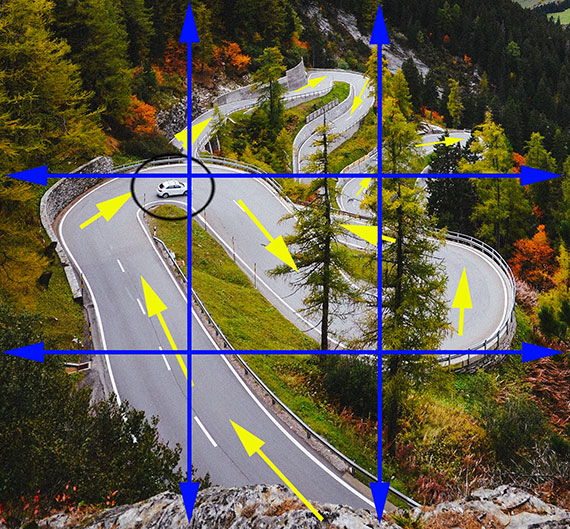
Photo by Johannes Hofmann
The second and most common mistake is that the leading line(s) lead away from the subject or past the subject of the photo instead of bringing the eyes to the subject.
In the example photo above, the car is the subject as indicated by the placement within the frame.
The road is a leading line.
The problem is that the car doesn’t have enough visual weight to stop the eyes at the subject, and the eyes continue down the road.
This picture is an example of a leading line that isn’t working very effectively as it leads past the subject.
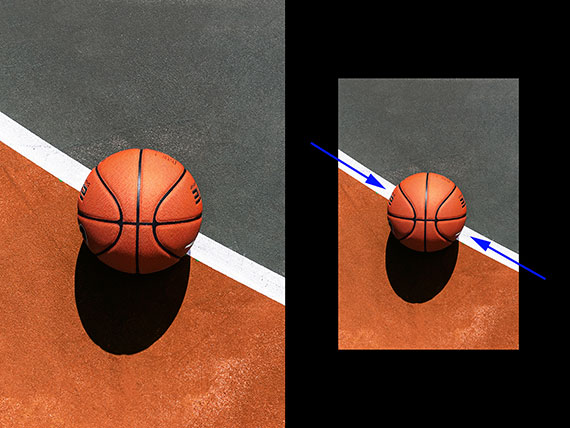
Photo by tommy boudreau
The common misconception about leading lines is that they must always lead into the picture from foreground to background.
In the example photo (above) the basketball is the subject. The white lines on either side of the ball are leading lines. They lead the eyes toward the subject.
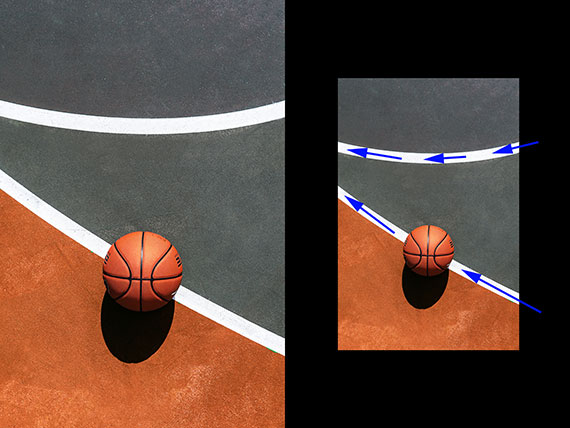
Photo by tommy boudreau
What if the photographer framed the scene like this example photo above? Do the leading lines still perform the proper function?
No. Now the lines lead the eyes off of the frame to the upper left.
The visual weight of the two heavy white lines merging at the edge of the frame carries significant visual weight.
They overpower the basketball and lead the eyes away from the intended subject.
Skill Points for Leading Lines
- Identifying leading lines within a scene.
- The leading line(s) should point toward the subject or near the subject.
- A leading line can cause a composition problem if it leads past the subject.
- A leading line can be created by light and shadow.
- A leading line can be created by color contrast or with a single power color.
- A pattern can create a leading line.
- You can use leading lines within a composition that runs horizontally, vertically, or diagonally even if they don’t lead into the picture.

Photo by Tyler Nix
Let’s revisit point number three on the skill points list.
We previously discussed a leading line that worked against the subject in the car photo on the curvy road. The reason was that it led past the subject.
However, nothing in photography is set in stone.
The above photo also has a leading line that continues beyond the subject. However, in this case, it isn’t a problem.
Remember This: The most crucial element in any photograph is the visual weight of the subject. The subject should be visually dominant, even if every other component of the photo is piled up against it, the subject clearly stands out in the frame.
This reasoning is why the above photo still works even though the leading line leads past the subject!
Critical Thought: If a leading line leads past your subject, introducing a break in the leading line at the point of the subject, can tip the scale of visual weight back in favor of the subject. This composition tip is the case in the above image.

Photo by Thom Holmes
There are some very definite lines in this image. The intent was for them to lead the eyes to the subject.
However, there’s a problem here.
Color contrast is a strong composition element. It can easily dominate a composition, and that is what’s happening here in the photo of the hiker.
When you look at this image, the first thing to catch your eyes is the yellow and orange jacket.
Then what happens?
The lines of the trees lead your eyes up away from the subject.
This motivation is enhanced by the wide-angle upward perspective and the change in tonal value from dark to light.
The trees aren’t working as leading lines in this use.
Okay. What happens if you’re in this situation and want to make the most effective picture possible while using the trees as leading lines to the subject?
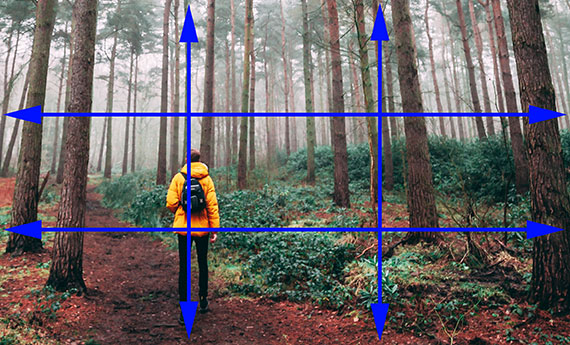
Photo by Thom Holmes
Analyze your scene.
This photo tells the same story as the previous version. Except, now the subject is dominant, and the trees lead toward the subject and not away from the subject.
Equipment
Some excellent news is that leading lines can be used with any camera equipment. That means any camera, including your mobile phone camera. It also means that any lens can work as long as you put some thought into composing the frame.
Lighting
Lighting that creates tonal contrast can also create leading lines.

Lighting leading lines
The subject of this photo is the doorway. Contrast formed by light and shadow has created leading lines that direct the eyes right to the door.
Remember: Lines of contrast can also work as leading lines.
Here’s a Helpful Tip: If your camera (including a mobile phone camera) allows you to turn on a Rule of Thirds grid, you should do so. Having the grid on will help you see how your leading line(s) moves through the frame and interacts with other elements, including the subject!

Photo by Etienne Girardet
As I stated in the skill points list, color contrast can often create a solid leading line. Make sure the line is working with your chosen subject.

Photo by Johannes Hofmann
Here’s another variation on color contrast in a leading line. In this case, part of the leading line is the area of color contrast, and it’s also the subject of the photo! This image is a brilliant use of a leading line.
Previously, I mentioned power colors. The power colors that carry the most visual weight in a photographic composition are red, yellow, orange, white, and black.
The above photo works well because of the power color red. If the train had been blue, the effect would have been lost.
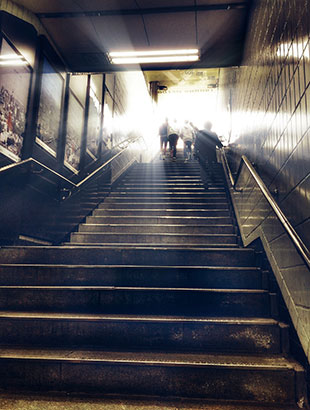
Photo by Kent DuFault
This example photo is an interesting case study for leading lines.
The two handrails form lines that lead right to the subject. However, there’s a third line. It comes from the sixth bullet point in the skills list.
The repetition, or pattern, of the stairs also creates a line up toward the subject.
This is interesting to note because, at first glance, one might say these lines are horizontal.
They aren’t leading toward the subject.
Individually looking at each stair, that would be true. However, as a group, in repetition, they form a distinct line moving upward toward the ascending group of people.
Critical Thought: When working with leading lines, visualize beyond the obvious of what’s in the scene. Objects like handrails, roads, fences, and the like are the easily spotted leading lines. Tonal changes and color contrast require a bit more work. However, you can do it!
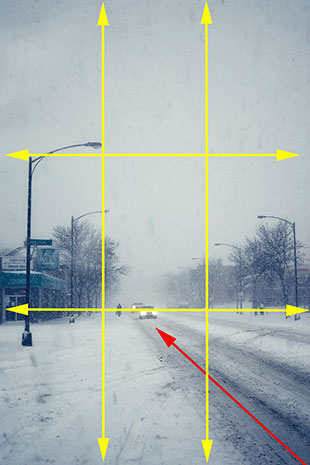
Photo by Kent DuFault
This photo taken during a blizzard is a typical leading line shot.
√ The subject is placed within the Rule of Thirds.
√ The light poles frame the subject.
√ The headlights are a focal point.
√ Finally, the road is a leading line.
Notice that the road leads directly to the subject, but not past the subject. At times, it’s okay for a leading line to extend beyond the subject. It depends upon the overall composition.
Now it’s Your Turn!
Grab your camera and kit bag and try the following.
1- Shoot a naturally found leading line of a physical object. Make sure that it leads to the subject and not past it (think of the Blizzard example and the Curvy Road example).
2- Find a leading line that leads nowhere. Then, insert your own chosen subject at the appropriate point along the leading line to achieve a great composition (think of the Trail into the Forest example and the Man in Forest example).
3- Use a leading line, or lines, to create a composition created by light and shadow (think of the Door example).
4- Create a picture with a leading line that enters the shot anywhere other than the foreground (think of the Basketball example).
Share your photos with family, friends, and colleagues. Ask them questions about the composition and your leading lines to determine if they got your intent for the image.
How did you do?
- Do your leading lines direct the eyes toward the subject?
- Do your leading lines support the subject without overwhelming the subject?
- Are your leading lines readily noticeable?
- Were you able to create a composition with a leading line that did not enter from the foreground, and did it successfully point toward the subject?
About the Author:
Kent DuFault is an author and photographer with over 35 years of experience. He’s currently the director of content at the online photography school, Photzy.com
For Further Training:
With summer here and readers looking for more photography practice near home, we were able to get another huge markdown on the popular Photo Action Cards – which includes cards specifically on using leading lines. Expand your photography skills with 65 printable project sheets that will give you over 200 photography assignments, covering everything you can imagine. They are currently 88% off today if you want to try them out.
These Action Cards discuss a photographic topic, provide you with suggested considerations, and give you specific photographic assignments. They’ll kick you out of the “nest” to go have a personal discovery experience all on your own.
Deal found here: The Photography Action Cards at 88% Off
Like This Article?
Don't Miss The Next One!
Join over 100,000 photographers of all experience levels who receive our free photography tips and articles to stay current:








Leave a Reply